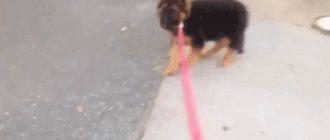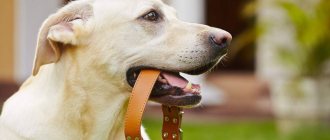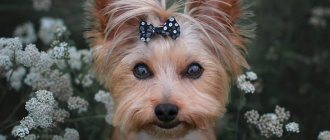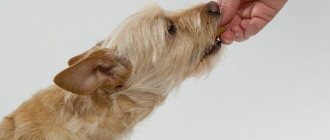Pit bull terrier is a serious breed, once bred as a working breed, which is why the standards of its appearance were developed taking into account the needs of that time.
Thus, the tradition of cutting the ears and tail of representatives of working breeds originated in ancient times, when it was believed that a long tail could provoke rabies, and too long ears were a weak point in a fight with other predators.
That is why terriers had such a specific appearance in recent centuries, until at the end of the 19th century England abandoned cosmetic surgery, considering it too cruel. Almost 100 years later, at the end of the 20th century, Germany followed suit, followed by almost all of Europe.
Today, most European exhibitions do not allow animals that have undergone cosmetic modifications to their appearance. Owners of such modified animals may face serious penalties.
Gradually this fashion is coming to us. However, until now, in the countries of the former CIS, many owners traditionally prefer to dock terriers in order to give them a familiar appearance, as in old photographs.
When is this operation prohibited?
As with any serious surgical intervention (and ear amputation is what it is), ear cropping has its contraindications. Such intervention is not performed on sick, weakened, or abnormally developing pets. Also, simply inappropriate age can become a valid reason for a ban on the procedure.
Read also: Cheating reposts on VKontakte
The operation is carried out in specialized veterinary clinics, less often - at home. This is due to the fact that in an equipped operating room all rules of sterility are observed, the necessary tools are at hand, so it is easier to react and stop unplanned situations.
The likelihood of complications after an operation in a good clinic is much lower than after an operation carried out in a homemade way. The result is also easier to predict.
A beautiful new shape of ears, exactly the one the dog’s owner wanted, is most often achieved thanks to the professionalism of the doctor, the correct location for the operation and the quality of the instruments and medications used. However, an equally important role is played by a decent postoperative period, for which the owner is responsible.
Read also: The role of glycerin in soap production
You shouldn’t save money once you’ve decided to change your pet’s appearance. A high-quality operation may be expensive, but the result will leave the owner satisfied. Otherwise, they can simply ruin the dog’s ears - asymmetries arise, complications occur in the postoperative period, and sometimes chronic ear diseases begin.
How to care for cropped ears?
How to care for the animal’s cropped ears after the operation? The main thing is to monitor the healing of the wound; animals often experience severe itching in the damaged area, so you should avoid scratching them.
- To prevent the dog from tearing off the protective bandage, use neck collars designed for this purpose; they can be purchased at any veterinary pharmacy;
- You can also make this collar yourself using cardboard or non-rigid plastic. This collar should not be removed until the dog's ears have healed;
- Immediately after surgery and for several days, the dog must take analgesics to relieve pain. The dog should eat as usual;
- The seams are treated with a solution of brilliant green and three percent hydrogen peroxide. This is done using cotton pads or tampons.
You need to monitor the dog, prevent infection from getting into fresh wounds, and monitor the condition of the stitches. If any deterioration in the animal’s health is noticed, contact a veterinary clinic immediately.
Preparation and technique of surgery
The owner of Central Asian Shepherd puppies is highly discouraged from carrying out the procedure for developing the exterior standards of the breed himself. Only an experienced veterinarian can crop ears and tails at home. Sometimes the breeder takes on these functions. In any case, aseptic and antiseptic standards must be observed.
The operation must be performed together; the owner must fix the newborn on the table in a lying position and close the animal’s eyes with his palm. The pet will make attempts to free itself and may twitch or squeak at the time of the incision; the owner’s task is to maintain a stationary position of the head or tail during the entire procedure. Typically, the ear and tail docking process takes about 3-5 minutes.
Ear cropping can only be performed by an experienced specialist.
The baby's ear is straightened, the skin is disinfected with a 70% alcohol solution, the auricle is slightly stretched, and the soft tissue is cut with sterile scissors. The wound is immediately treated with an antiseptic solution or spray. The second ear is cut in a similar way. Docking the tail is done by pulling the skin fold towards the base of the tail with cartilage scissors, followed by treating the wound with an antiseptic.
All the pros and cons
There is a theory that trimming the tips of dogs' ears is aimed at preventing otitis media, but veterinarians question this fact.
Basically, the goal of breeders is to adjust the appearance of the pet to the established canons of the breed.
The American Pit Bull Terrier is a muscular, handsome man with a fighting disposition, and with uncropped ears he loses his menacing appearance. Also, this appearance may not be suitable for some exhibitions.
The arguments against are more humane. Scientists have proven that ears play an important role in the communication abilities of pets, and also signal the owners about the mood of their younger friend.
Consequently, cupping deprives them of the opportunity to fully communicate with the outside world.
Many experts argue that there is no medical need for such manipulations, and abroad, cropped ears are already considered unaesthetic.
Why is ear cropping done on dogs?
Let's look at this issue from each side's point of view. Why is there a need for such a procedure? The very first reason for cropping dog ears can be considered the requirements of the breed standard.
Read also: Photo ideas for a manicurist
In most cases, such requirements apply to dogs of hunting and fighting breeds. If an animal, by virtue of its purpose, must fight with any predator or other dogs, then damage to the elongated, uncut ears can play a cruel joke on the animal. This can turn the result of the fight not in favor of our dog.
Some owners of fighting breeds believe that after the docking procedure they give the dog a more aggressive appearance. However, in many countries of modern Europe, such views on the external standard of the breed are very outdated. At some dog shows, animals with cropped ears are not even allowed to participate.
In our country, there is no such trend yet; among the old school dog handlers there are still many animal owners who believe that cropping a dog’s ears is quite acceptable and even necessary if this is put forward by the requirements of the standard.
The second reason for ear cropping in dogs is due to medical requirements. Uncropped dog ears can cause some illnesses in the animal. For example, soldiers of the Roman Empire always cut the ears of their fighting dogs, because they seriously believed that such an animal was not only more difficult to wound or kill, but also that it would be protected from rabies.
Since then, this bloodthirsty tradition for dogs began. Cropped ears are much less susceptible to bites from mosquitoes, ticks and other insects, and the likelihood of foreign objects getting into the ear canals is also reduced.
If you look at the other side of the coin, many dog breeders believe that cropping can provoke ear inflammation (otitis) in dogs, coupled with the appearance of many other problems. But still, sometimes ear cropping is really necessary, in case of any ear diseases lesions such as neoplasms, large wounds, necrosis or burns.
Sometimes it happens that the breed standard changes because the purpose of the animal changes its meaning. Thus, a guard dog that is supposed to have its ears cropped can gradually become a companion dog that does not need to have its ears cropped. For example, this is exactly what happened with the miniature pinscher.
Contraindications for ear trimming in dogs
Like any surgical operation, cropping dog ears also has contraindications and prohibitions. For example, the procedure cannot be performed if the young animal has any deficiencies or abnormalities in its growth and development. Also, this should never be done if the animal is sick. It is worth temporarily postponing the operation even when the dog has a high fever or there is discharge from the ear canals.
A prerequisite that must be strictly followed is monitoring the sterility of the operating room where the animal will undergo the procedure. All instruments must be disinfected, and the animal’s ears must also be treated with an antiseptic solution. Otherwise, this may lead to serious health problems for your pet.
Why do my puppy's ears fall off?
Every puppy at birth has small ears pressed against its head. The dog grows, develops, and the structure of the ears changes along with it. The cartilage in them becomes stronger, the auricles become larger, and the ears gradually straighten.
The size and shape of this part of the body cannot be changed: they will depend on heredity. But the strut can still be corrected if it is not caused by serious deformation. Otherwise, only a surgeon can help.
Puppies of different dog breeds
The ears may rise very slowly or remain drooping. In some cases, already raised ears may fall or stop rising for a while. The reasons may be:
- Deficiency of microelements and vitamins in the pet’s body. The main element that should be present in the diet of a growing dog is calcium. It is the basis for the construction of elastic and strong cartilage. If there is not enough calcium, all the microelement entering the body is spent on the formation of bone and dental tissue. It enters the cartilage last.
- Replacement of baby teeth. All reserves of the dog’s body during this period are aimed at the formation of strong molars. A smart body uses vitamins to create more important structure. Therefore, the cartilage in the ears simply does not have enough nutrition.
- Vaccination. If your pet has recently been vaccinated, the process of raising the puppy's ears may be delayed. This is due to the fact that injections are very stressful for a dog’s body. Do not worry: after the pet recovers from the procedures experienced, the process of raising the ears will resume.
Puppy vaccination
- Voluminous and fleshy ears. Even the strongest cartilage cannot lift ears that are too heavy and voluminous. Therefore, the owner’s gorgeous ears will need help.
- Purity of the breed. A purebred puppy should only be purchased from a trusted breeder. An unreliable seller can sell a mixed breed with deviations at the price of a purebred animal. And it is possible to straighten the ear cartilages of a puppy who was born from a mating between a purebred mother and a lop-eared dog in isolated cases.
In older dogs, the cartilage may sag due to injury that damages the cartilage. A dog may pinch or severely injure its ear during a fight with another dog. In this situation, you should contact a veterinarian. The further prognosis and ways to eliminate the problem depend on how seriously the ear was damaged.
Important! If a growing puppy’s ears still do not rise, then they need to be corrected as soon as possible. Otherwise, in an adult dog, the situation can only be corrected through surgery.
Puppy with soft ears curled to the sides
Preparation
Before docking, the dog must be shown to a veterinarian. If there is the slightest doubt that the pet is absolutely healthy, the procedure should be postponed until complete recovery.
Preparation immediately before the manipulation is as follows:
- After 12 hours, the puppy stops feeding, but water can be given in the same volume as usual.
- Local anesthetics are used for puppies, and general anesthesia for adults.
- The fur from the site of the future incision is shaved smoothly, and then this place is thoroughly disinfected with special solutions.
- The dog is placed on the table, after which the front legs are fixed in an extended forward position, and the hind legs are extended back. In older puppies, the lower jaw is also fixed.
Necessary care
For the health and long life of a dog, you need to take care of its nutrition and living conditions. You can feed him either specialized dry food or cook your own food. To prepare your own food, you need to choose fresh, high-quality products.
The pit bull's diet should include meat (preferably beef), boneless fish, fermented milk products (cottage cheese, milk), a variety of vegetables and fruits, and boiled cereals. Vitamin complexes are required. For example, WOLMAR WINSOME (a supplement in the form of a soluble tablet that has a positive effect on the dog’s body).
An adult animal needs to be fed 2 times a day after morning and evening walks. Puppies eat 3-5 times a day.
When caring for your pet, don’t forget about bathing and brushing. The dog is short-haired, so it does not need frequent bathing. You need to bathe as needed (once every 1-2 months). You can brush it once a week with a stiff brush to remove dirt from the coat.
Veterinarians' opinions
Specialists are always reluctant to undertake the cupping procedure. Surgical intervention in the normal structure of the body is always a risky step that should not be taken without serious reasons.
Breeders and other lovers of the breed also note that undocked pit bulls are more obedient and playful, generally behave more balanced and are more willing to make contact.
Ear cropping is in most cases a fashion statement, and not a justified necessity.
Since dogs' ears and tails are cut at a tender age, you need to be careful when choosing a surgeon. The baby’s psyche at this moment is not yet formed, so incorrect actions by the veterinarian, poor care of the puppy after surgery and recovery with complications can cause irreparable damage to the four-legged friend.
Therefore, if the pit bull does not belong to the show class, it is much better to avoid the dangerous procedure.
Depending on the breed standard, it is sometimes necessary to perform ear cropping on dogs. There are different breeds of dogs, tall and short, long and short, with floppy ears and erect ones. And in order to improve the appearance of the animal, this procedure is needed.
Dog handlers have different approaches to this, in principle, cruel, but extremely necessary procedure. Some are categorically against such abuse, others argue for the benefit of this manipulation by the fact that many dogs need it due to certain medical and historical reasons. Based on this, many other, side questions arise, for example, such as the one - is it possible to crop the ears of an adult dog?
A little history
In most cases, owners perform such an operation on their pets, following fashionable traditions, and not the need for the dog’s health.
Although our ancestors thought differently: an uncut tail, for example, promised a dog rabies, and among fighting breeds it was a weak point during a fight with a wolf.
Despite the prevalence of cosmetic surgery, in some European countries such an act towards a younger friend is considered animal cruelty and is prohibited.
For example, in England since the end of the 19th century, and in Germany - the 20th century, docking has been prohibited by law and provides for severe punishment for dog breeders.
More and more international canine shows do not allow dogs with cropped tails and ears.
But still, in pursuit of conformation standards, many dogs undergo a painful procedure.
Possible complications
After surgery, severe bleeding may occur. It can be removed with veterinary powder or pencil. If it does not go away, you need to take the pit bull to the clinic.
If an infection occurs in a wound, then it is necessary to determine the type of pathogen and select a drug that acts specifically on this microorganism. To do this, tests are taken at the clinic.
If the dog is an adult, seals and scars may form on the cuts, which are clearly visible due to the short hair of pit bull terriers. Nothing can be done about this - you cannot subject the dog to the operation again, and the result will most likely be the same.
Features of the procedure
It is better to make a decision about the need for docking in advance, since the younger the dog, the easier the operation and recovery after it will be.
As a rule, pets have their ears cropped at one week of age.
The pitfall of carrying out manipulations at such an early period is the inability to determine in advance the general appearance of the muzzle and body of an adult dog.
Also, dog breeders are guided by the vaccination schedule. It is better to trim the ears a week or two after vaccination, between one and a half to three months of the puppy.
It must be remembered that the sooner cupping is performed, the more beautiful the shape will be and the smaller the scar left on the ear.
Therapeutic indications for such surgical intervention may include tissue necrosis, neoplasms and ulcers of the auricle.
As with any operation, complications may arise:
- individual intolerance to anesthesia;
- sudden bleeding;
- infection in the wound.
In any case, to avoid negative consequences, it is necessary to contact only specialized veterinary institutions.
Features of the American Pit Bull Terrier
Television, newspapers and the Internet often present information about these dogs exclusively in negative terms. Stories about pit bull terriers attacking their own owners and killing children instill panic and fear in the average person. But is the pit bull as bloodthirsty as the media portrays it to the general public?
The American Pit Bull Terrier is very affectionate and gentle towards its family. Due to their small stature and compact size, smooth coat and lack of salivation, representatives of this breed are ideal candidates for keeping in city apartments. He will feel comfortable in a private home. Despite the fact that the pit bull has a wayward character and is prone to dominance, he is so devoted to his owner that he is ready to give his life for him. He can be trained to be an excellent bodyguard, but he's not a good watchman. And all because a friendly attitude towards people has been brought up in pit bulls since the birth of the breed.
It is strictly not recommended to keep these dogs on a chain. Unlike German shepherds, which become stupid from being constantly on a leash, pit bulls on a chain become aggressive. They, being tied, of course, begin to guard the territory. But this is more out of despair than out of “calling,” because this breed does not have protective qualities. Often, when chained, they go completely wild, which can later backfire on the owner. Hence the myths about the “bloodthirstiness” of pit bull terriers. It is regrettable that in press reports about real cases of dog attacks on people, as a rule, the reasons for the aggression are not mentioned. But it is alien to the nature of pit bulls and is usually provoked by unfavorable circumstances. Most likely, reporters simply don’t know about these “pitfalls”...
How to install undocked ears on small dogs: detailed instructions
Problematic uncropped ears in representatives of all small or decorative breeds are diagnosed by analogy. Let's study the procedure in detail using the example of the Chinese Crested. You can begin setting up the ears of a representative of this breed as early as one month of age.
Table 2. Algorithm for setting ears for miniature dog breeds.
| Stages | What do we have to do |
| Step 1 | Find an assistant to help restrain the dog. Long hair will have to be shaved off, and the dog's head will need to be held still so as not to damage the delicate skin on the ears. |
| Step 2 | Prepare the trimmer, secure the dog and shave the hair from the inside and outside of both ears. Ears that are completely free of hair will become much lighter, and removing the adhesive bandage will be less painful. |
| Step 3 | The sound and vibration of the trimmer may frighten your pet, so during the procedure you need to constantly reassure him and talk to him gently. You need to work very carefully. At the base of the ear on the inside there is a thin partition that should not be touched at all. |
| Step 4 | Use scissors to trim off the remaining hair around the edges of the ear, then wipe the cartilage inside and out with alcohol or another degreaser. This way the patch will stick better. |
| Step 5 | Separate a piece from the patch corresponding to the length of the ear. Place it on the table in front of you with the adhesive surface facing up. Measure the cotton swab along the length of the ear, cut off the required length and place it on top of the adhesive plaster. |
| Step 6 | On top of the cotton swab, you need to stick two more layers of the patch of the same length as the first. Cut the resulting “tire” to the shape of the ear so that the fleece points down. |
| Step 7 | Stick the resulting structure on the inside of the ear so that the ear canal is clearly visible. Wrap the ears in the form of tubes, but without enthusiasm, so that the dog does not experience discomfort. Repeat the algorithm from the very beginning with the second ear. |
| Step 8 | Wrap each ear at the base with adhesive tape. There is no need to bring your ears close to the top of your head, as this may cause them to stand up incorrectly. The dog's muzzle along with the structure should look natural, the ears are straight and stick up. |
With such a design on the head, the pet will have to walk for about 5 days. After this, the patch must be cut and carefully unscrewed, freeing or cutting off the stuck hairs. Sometimes the ears stand up after the first procedure. If the desired result is not obtained, after a day's rest the procedure must be repeated from the first step. You can carry out the procedure until the ears are completely straightened.
The process of gluing the ears of a Yorkshire terrier
Important! The Chinese Crested breed has two varieties - fluffy and hairless. The ear straightening algorithm is suitable for each variety. The breed standard states that the Hairless Crested must have ears extended upward, and for the downy breed any arrangement is possible. However, breeders are confident that the downy Chinese Crested with erect ears looks much prettier.
Operation stages
First, the veterinarian measures the dog's ears and determines the location of the cartilage. You can attach templates with different shapes to see which one looks best. The dog is weighed and put under anesthesia.
Each ear is treated in turn with an antiseptic, then cut from the outer edge to the inner according to the intended shape. The cut is disinfected, a suture is placed on it, and the wound is bandaged. Many veterinarians ask owners to be present during surgery so that the puppy feels protected and supported.
It is important that the seam is located only on the skin and not on the cartilage. Otherwise, as healing progresses, the shape of the ears will become deformed, and complications are possible.
The procedure can be carried out at home. The Pit Bull Terrier will feel more confident and comfortable. To do this, you need to call a veterinarian to your home and provide sterile conditions. The ear trimming procedure lasts no more than 5-10 minutes.
Photo gallery
We present for your review a selection of photos of four-legged pets after the ear cropping procedure. This may give the dog some charm, but it is not very humane towards your pet.
We simply cannot imagine representatives of certain dog breeds without cropped ears. Their circumcision is a cosmetic surgery. It is carried out for puppies of the following breeds: Doberman, Shepherd, Staffordshire Terrier, Great Dane, Pit Bull Terrier, Miniature Schnauzer, Boxer, Miniature Schnauzer, Cane Corso, Giant Schnauzer, Doberman Pinscher. Let's learn about all the intricacies of ear cropping for dogs.
Until what age do dogs have their ears cropped?
The easiest time to undergo the operation is shortly after birth. Up to 2 weeks, babies are less sensitive to pain and do not remember it, and their tissues regenerate much faster. The only negative is increased bleeding.
After 4-6 months, the pain worsens, and large scars often remain at the site of circumcision. For this reason, the average age for ear cropping in dogs ranges from 2 weeks after birth to 3 months, and the maximum is 4-6 months. At a later age, amputation is resorted to only for medical reasons.
Optimal age for cupping
Experts call completely different dates. Some crop ears at the age of 1-2 weeks. At this time, the pit bull puppy’s blood vessels and nerve endings at the site of the cut are not yet sufficiently developed, which means that during the operation he will lose little blood and the baby will not be in as much pain.
Others believe that the optimal age is 2-3 months. But such deadlines are dictated only by the requirements of the exterior. At this age, you can already predict what an adult pit bull with cropped ears will look like.
Why do you need to crop your ears and tail?
Previously, this procedure was necessary. Fighting dogs and shepherd dogs always had their tails and ears docked, since during a fight these were the most vulnerable places.
In addition, people believed that an uncut tail was a direct threat to a dog's health and could cause rabies. Today it is absolutely obvious that these two facts have no connection.
Which leads to the conclusion: if the pit bull does not perform a special function - guarding or fighting, the procedure will not bring any benefit to the pet.
Is it possible to leave it undocked?
Currently, in all EU countries, the operation is regarded as inhumane treatment of animals. In England, docking has been officially prohibited since the end of the 19th century.
Dog handlers are also confident that ears perform an important communicative function in dogs and play a large role both in communication with other four-legged animals and with humans. By their position it is easy to determine what mood the pet is in. A pit bull with cropped ears is deprived of the opportunity to fully communicate with the world.
Every year the number of international exhibitions where dogs with docked ears and tails are not allowed is growing. But the pit bull is an American breed. The United States has not signed the European Convention for the Protection of Animals and continues to adhere to its breed standards.
This procedure is still popular among pit bull terrier owners. The fact is that the owners of pit bulls are young people who value the dog’s menacing appearance. People who are interested in appearance choose a fighting uniform for pitbull ears.
From all of the above we can draw a conclusion. If the dog is a representative of the pet class, has minor flaws in its appearance and does not participate in exhibitions, then it is quite obvious that it is better to leave the ears and tail of the pit bull terrier undocked.
Still, in some cases, ears are cut off. There are the following indications for the operation:
- necrosis (death) of tissues;
- tumors, both malignant and benign;
- ulcers;
- incurable injuries;
- If the dog serves as a guard, cutting the ears will reduce the risk of attack by wild animals.
Why do you need to put on dog ears?
Straightened ears are, first of all, a confirmation of the dog’s elite status. Dogs with long ears that stick out upward look more masculine and impressive. But this procedure is carried out not only for aesthetic reasons: dogs with erect ears are less likely to develop hearing diseases.
Some owners do not pay much attention to the ears, perceiving the puppy as he is. After all, the standards of some breeds imply both a straightened and saggy position.
If the lop ear is not the result of damage and is not a congenital mutation, the owner himself can correct it. But before studying the process itself, it is necessary to get acquainted with the breeds whose representatives’ ears are designed to stick up.
Important! It is especially important to have erect ears for those four-legged pets that are being prepared to participate in exhibitions. However, the decision about whether a pet needs ears installed always depends only on the desire of the owner.
Dog with erect ears
Performing ear cropping surgery
Interested in how dogs' ears are cropped? Different dogs get new ear shapes differently. Ear cropping is done at a strictly defined angle, and a special set of ears is also installed, in accordance with the same notorious breed standard. For example, almost the entire ear of Caucasian Shepherd dogs is cut off, and about two-thirds of the ear of pit bulls is removed.
The edge of the ear is often made smooth and straight, but sometimes it can take the shape of the English letter S. If the dog is a Great Dane or a Pinscher, then the ear should have a pointed shape. The process of ear trimming usually does not take very long, a maximum of half an hour, but sometimes, depending on the circumstances or complications, it can take up to an hour and a half.
- Small puppies are given local anesthesia, but adult dogs need general anesthesia;
- The owner must be present with his dog, he must keep him at the required distance that is safe for the veterinarian. After all, a frightened animal can seriously tear or bite a person in a white coat;
- The dog must be held firmly by the hind and front limbs. The owner must ensure that the animal does not move its body or twitch. Usually, for this purpose, the dog’s body is fixed with special strong belts. It is best to put a muzzle on the muzzle to prevent bites, however, if the dog is calm and not angry, then its jaws can simply be fixed.
What should you use to treat your ears after cupping or during it? The hair on the ears must be carefully trimmed and the skin treated with a special antiseptic. The set of tools that will be needed for the operation may include surgical scissors, as well as various clamps. They are placed on the ears during the procedure.
If the operation was successful and there is no bleeding from the incision site, then after ten minutes the clamps are removed and the edges of the wound are sutured or sealed with special glue. Of course, the wound is treated with various antiseptic agents to avoid bacterial infection.
How do you know if your dog's ear needs to be taped?
So, the owner noticed that the puppy’s ears do not straighten out well, they fall inward towards the top of the head or stick out to the sides, and dangle when walking. Now we need to find out whether the ear can rise on its own or whether gluing is required.
Step 1. Determine if there are any creases
It is necessary to carefully examine your pet's ear. If it collapses at the very base, it definitely needs support. Such an ear will definitely not rise without the help of the owner. It must be completely straightened and glued directly at the base in such a way as to completely prevent it from collapsing. The ear should be vertical.
A standard knob looks like a horizontal section with a very thin layer of cartilage. The ear cannot hold up normally and breaks in this thin place, falling forward. This situation can be prevented by feeding the animal calcium from an early age. But if a crease has already formed or is just emerging, it is necessary to glue the ear.
Dog with a crease in the ear
Step 2. Looking for scars and weak spots
If there are no creases, but the ear still falls down, it is necessary to examine it for scars and weak spots. Such areas inhibit development and prevent the healthy ear from rising. The inspection algorithm will be as follows:
- Squeeze the ear at the base with your thumb and forefinger. Start feeling it from bottom to top with your fingertips.
- Find the weak point that prevents lifting. It could be a small speck or a strip of thin fabric. To make sure this is the right place, pinch the spot between your fingers. The ear will rise and straighten as you hold it in this problem area.
- The spot located in the upper part of the cartilage does not require gluing. It is enough to start giving your pet vitamins to restore cartilage tissue. The ear will straighten and become stronger without outside help.
- If the weak area of the tissue is located in the middle of the ear or at its base, gluing is necessary.
If the owner has not found any weak points, but the ear is soft in itself and collapses completely, gluing will not solve the problem. It is necessary to first carry out a course of restorative treatment with vitamins and calcined products. When the cartilage becomes strong and complete, you can start gluing it if it does not rise on its own by that time.
Puppy with house ears
Postoperative care
On the first day, the puppy’s head must be bandaged to avoid excessive bleeding. When the bandages are removed, the ears are disinfected with a solution of brilliant green, and this is done daily. A protective collar is put on the dog.
While the specialist has not removed the stitches, the ears are gently massaged so that the skin does not wrinkle during healing. If your pit bull whines for a long time, your veterinarian may prescribe pain medication. Such drugs are necessary for adult animals. The stitches are removed by a specialist a week or 10 days after the operation.
If you need the puppy's ears to be erect, they are glued in a special way. Rollers are placed inside the ears and secured in a standing position.
Possible complications
Complications during cupping are the same as with any surgical intervention. It is necessary to keep the circumcision sites clean and constantly disinfect them to avoid infection.
It’s bad when a few days after the operation there is heavy bleeding - the dog needs to be shown to a specialist. In adult dogs, a typical complication is scars on the ears. Therefore, docking an adult pit bull terrier is quite rare.











